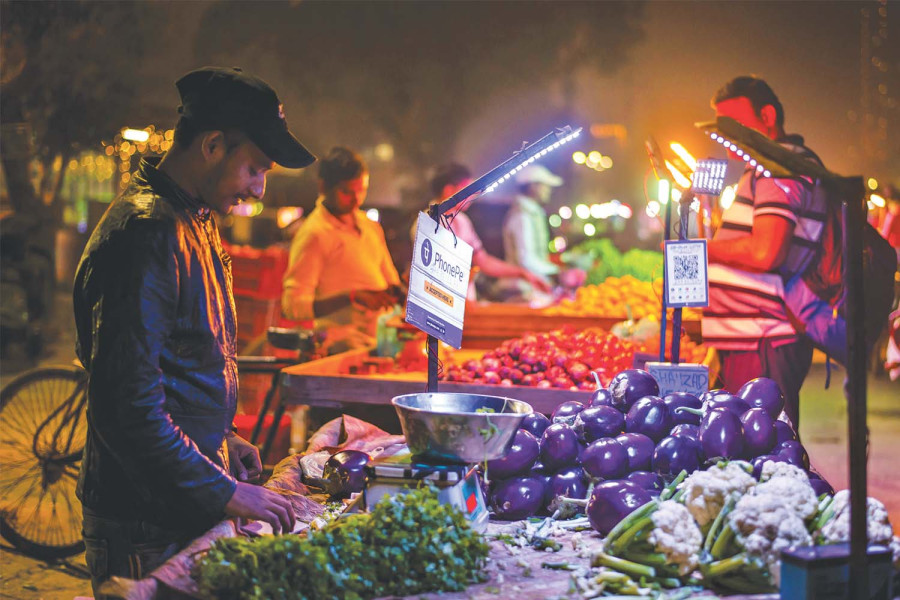National
Nepal to roll out QR code system in India by mid-July
The central bank has suggested capping payments made via quick QR code for Nepali nationals in India at IRs100,000 monthly.
Post Report
Nepal’s central bank is all set to launch the quick response (QR) code for Nepali nationals to make payments in India by the end of the current fiscal year, or July 15.
“Work is ongoing,” said a senior official of Nepal Rastra Bank, who requested anonymity. “As per the plan, the QR code in India will go live by the end of the current fiscal year.”
Gunakar Bhatta, executive director at the Payment Systems Department at Nepal Rastra Bank, said they are still working out the details for QR code payment and this is causing a slight delay in launching the system in India.
He said the system for allowing Nepali nationals to make payment through QR code will be just like the debit card system, and some adjustments are being worked out.
According to the central bank’s rule, Nepalis can make a transaction of Rs15,000 in a day and Rs100,000 in a month in India through a debit card. “We are focusing on substituting debit card payments with QR code payments while making payments in India.”
Once the transaction limit is worked out, it will not take time to launch the service, said the central bank.
On April 19, a panel formed by Nepal’s central bank prepared and published a draft of provisions related to international retail payments to be made through mobile and internet banking and inter-bank transactions through QR codes. It was then put on the Nepal Rastra Bank’s website to collect feedback from the public.
A month-long deadline was given to submit suggestions.
The central bank has suggested capping QR code-based payments for Nepali nationals in India at IRs100,000 (Rs160,000) monthly, either one time or cumulatively.
Bhatta said suggestions have been collected, and if there are any more, the central bank will collect them.
Starting March 1, Indians were allowed to make payments through their mobile phones, marking a milestone in cross-border digital payment between Nepal and India. Fonepay Payment Service partnered with India's NPCI International Payments to launch the cross-border payment service using quick response (QR) codes.
“The last two months, we had an opportunity to experience the operation of the QR code launched by India in Nepal. It has been good, especially in border areas where Indian tourists mostly make payments through QR code,” Bhatta said. “It has opened the previously untapped sector for transactions,” he said.
The central bank said the National Payment Switch concept will be implemented once Nepalis are allowed to make payments in India through QR code.
The proposed draft says there will be no limits on making payments through QR codes at hotels, hospitals (hospital and research centers), and medicine shops. The panel has proposed that the charges for QR code services should be determined by the market. However, the central bank can review the charges and limitations as and when needed.
Payments for purchases made through mobile phones have been seen as a milestone in cross-border digital payment between Nepal and India, addressing numerous hassles faced by citizens of both countries who rely on banknotes.
Although India implemented the system swiftly from March 1, the Nepali side has been dilly-dallying.
On June 1 last year, Nepal and India signed a memorandum of understanding for cross-border digital payment to ease digital transactions for business people, students, and tourists from both countries.
On February 15 this year, the Nepal Rastra Bank and Reserve Bank of India signed and exchanged Terms of Reference for interlinking India's Unified Payment Interface (UPI) and Nepal's National Payment Interface.
The integration is aimed at facilitating cross-border remittances between India and Nepal by enabling users of the two systems to make instant fund transfers at low costs.
QR code display stands are now seen everywhere—from vegetable shops to department stores, private business houses to government agencies. Central bank data shows that transactions through QR codes have been growing at a faster pace each passing month.
According to central bank data, in Nepal, from mid-March to mid-April, the total transactions increased to Rs45.67 billion from Rs42.56 billion the previous month, which was from mid-February to mid-March.
The number of QR-code transactions also increased to 16.10 million from 14.29 million during the review period.




 18.12°C Kathmandu
18.12°C Kathmandu














